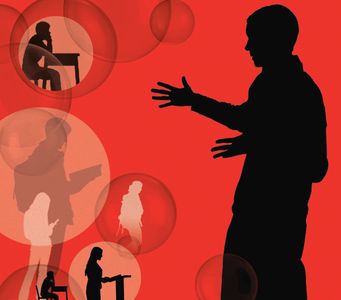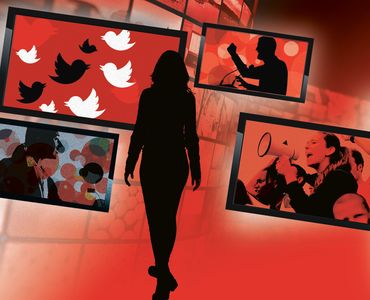Leading an Antiracist Classroom

Illustrations by L.J. Davids
Leading an Antiracist Classroom
How to teach for transformation and liberation amid battles over critical race theory
Critical race theory.
Over the past two years, the term has made its way into the mainstream, popping up in political campaigns, on cable news programs, and at school board meetings. Furor over the alleged teaching of critical race theory in America’s public schools has thrust a graduate-level field of study into the national lexicon. Almost overnight, school districts and state legislators began hearing from parents objecting to history lessons that point out threads of racism throughout US history, incorrectly claiming white students were being blamed for that history. Some school districts are removing certain race-themed books from libraries and classrooms, and state legislatures are stepping in. Since January 2021, more than 40 states have passed legislation or taken other executive actions restricting what students can learn in school with respect to race, in several cases naming critical race theory specifically. Many of these so-called “divisive concept” laws regulate in-school speech about sex and gender, as well as topics involving race—such as lessons about the history of slavery, treatment of Indigenous peoples, the Civil Rights movement, or, most recently, the killings of Black Americans by police.
In the 17 states where these concept laws have passed, teaching about race and diversity in school has become more difficult than ever—right when we need it the most, says Rob Martinelle, a lecturer in curriculum and teaching and social studies education, who researches justice-oriented teacher development. He says many critics of so-called divisive concepts adhere to what he calls the “neutrality myth”: that teachers and schools are completely neutral and lack agency over their actions and what they teach.
“As teachers, we strive not to be partisan, but every decision that teachers make is political. All the books we include or do not include are political decisions, the students we call upon or do not call upon are political decisions,” he says, adding that teachers he knows feel a particularly high level of pressure at the moment. “I don’t envy the position they’re in.”
BU Wheelock scholars are eyeing these developments with alarm and are drawing on their research and experience to help educators understand and face the issue in their schools and classrooms.
The backlash to critical race theory “is picking up on the fear and confusion about what to make of systemic racism or oppression in general,” says Grace Kim, a clinical associate professor in counseling psychology and coauthor of a timely new book, Teaching Diversity Relationally: Engaging Emotions and Embracing Possibilities (Routledge). Students, she adds, are the ones who lose in these debates. “We are taking away opportunities from children to grapple with really important issues like race, gender, and sexual orientation—all of those things that certain adults may feel are taboo topics.”
A Little-Known Concept

Just three years ago, critical race theory was virtually unknown outside a tiny number of graduate school lectures. The 40-year-old academic and legal school of thought explores and critiques American society, history, and institutions of power through the lens of race. Put another way, critical race theory looks beyond racism as merely the product of individual prejudice or bias, and explains how the belief is embedded in the nation’s legal systems and policies, according to Kimberlé Crenshaw, a law professor at UCLA and Columbia and one of the framework’s architects.
In the wake of the killings of Black Americans at the hands of police over the last several years and subsequent calls for racial reckoning, Martinelle says conservative activist Christopher Rufo
We are taking away opportunities
from children to grapple with really important issues like race, gender, and sexual orientation—all of those things that certain adults may feel are taboo topics.
found in critical race theory a convenient boogeyman to which he could shift attention away from policing and race in the national conversations. In articles, social media posts, and media interviews, Rufo and other commentators began pointing out instances where the theory was supposedly being taught to K–12 students. Rufo falsely characterized critical race theory as inherently racist itself, pitting white students against students of color. Rufo was clear about his intent to make the phrase “toxic,” tweeting in March 2021, “The goal is to have the public read something crazy in the newspaper and immediately think ‘critical race theory.’”
“[Rufo] wanted to make [critical race theory] a catchall for everything that makes white people uncomfortable,” Martinelle says.
Since January 2021, 42 states have introduced bills or taken other steps that “would restrict teaching critical race theory or limit how teachers can discuss racism and sexism,” according to a frequently updated EducationWeek analysis. A number of the bills or executive orders ban content that causes students to “feel discomfort, guilt, anguish, or any other form of psychological distress” on account of their race. In Florida’s board of education rule banning critical race theory, passed in July 2021, curricula cannot imply that “racial color-blindness is racist.” An Indiana law, which was vetoed by the governor there, would have banned “race-based scapegoating.” A June 2021 New Hampshire law bans content “promoting a negative account or representation of the founding and history of the United States of America.” In Texas’ law, signed in May 2021, teachers must address a “controversial” contemporary issue from “diverse perspectives.”
The laws are, in many cases, already hampering teachers’ freedom to tell students the truth about current and historical events involving race—just as they were designed to do. For example, after the murder of 11 Black shoppers in a Buffalo, N.Y., grocery store in May, a teacher in Austin, Tex., told her ethnic studies class—which was made up largely of students of color—that her state now required her to offer an alternative perspective on the gunman’s racist motives: “Another perspective is that this young man was out defending the world—or his kind—from being taken over.”

How did we get here? For Assistant Professor Davena Jackson, the answer is clear: white supremacy. Historically, schools have taught curricula that do not honor the lives, knowledge, histories, and experiences of all people, she says. But some schools are beginning to make curricular and pedagogical changes that affirm the humanity of students, especially Black and brown students, who have been historically marginalized, Jackson says. Educators have begun to “decenter whiteness” in classroom curricula—“providing opportunities for students to name, to interrogate, and really begin to dismantle notions of anti-Black racism and white supremacy.
“Decentering of whiteness led to, ‘Let’s talk about critical race theory’—it’s getting away from the actual conversations that we need to have, which should be about how schools can humanize the lives of all students. Disrupting anti-Black racism, white supremacy, et cetera, and ensuring more just and equitable experiences for marginalized communities is important and necessary,” says Jackson, whose academic work centers on teachers’ justice-oriented commitments and curricular and pedagogical choices that lead to the transformation and liberation of English classrooms.
The challenge extends beyond the classroom, Martinelle adds. The history that Americans of a certain age grew up with was more of a mythology rather than facts, he says. Today, Americans must let go of those comfortable myths as they learn, some for the first time, about the genocide of Indigenous peoples by early colonizers, the generational fallout from enslavement of Black people, or the systematic exclusion of people of color from receiving home loans or benefitting from New Deal programming. “This is, among many things, a backlash against that,” he says.
The effort to control, for political purposes, what kids can and cannot learn in school is not new. Martinelle points to campaigns in the early 20th century to scrub southern grade school textbooks of content that reflected poorly on the Confederacy and its adherents—namely, that it fought the Civil War over the right to enslave Black people. Martinelle, a former social studies teacher, has recently been researching the state laws being passed and their implications and calls the current backlash against critical race theory “the myth of white victimhood, recycled.”
The Stories We Tell
In addition to the statehouse and the classroom, the school library has become a front line in the war on critical race theory and other so-called divisive concepts. According to the literary and free expression advocacy organization PEN America, 1,145 book titles were taken out of school libraries, classrooms, or both between July 1, 2021, and March 31, 2022. Encompassing fiction, young adult and children’s books, graphic novels, and verse novels, most of the titles in PEN America’s banned books index contain prominent characters of color or LGBTQIA+ identities, or discuss race and racism in US history, gender identity, sexuality, and rights and activism.
“The entire idea of the American school system is that what we read shapes who we become,” says Laura Jiménez, associate dean, equity, diversity, and inclusion, and senior lecturer of language and literacy education. “It’s a great control mechanism.”
As it is, some students in US schools can “go a whole K through 12” without seeing their culture or identity represented in the books they are assigned to read in school, Jackson says. She calls the removal of books that celebrate diversity “traumatizing.”
Jiménez has advocated that English language arts teachers choose reading materials with social justice in mind. Instead of assigning To Kill a Mockingbird, which portrays Black people in a problematic light, “why don’t we read books by African Americans, about African Americans?”
“In my classes [at BU Wheelock], I only teach books that are by and about marginalized communities,” she says. “I made that decision years ago, and I haven’t looked back.”
Navigating the Storm
Divisive concept laws are unlikely to stand up in court as constitutional, Martinelle says. In New Hampshire, a lawsuit brought by a group of educators, the American Civil Liberties Union-NH, and the National Education Association challenges the state’s 2021 law that discourages public school teachers from teaching and talking about race, sex, sexual orientation, disability, and gender identity in the classroom. Other lawsuits may follow, but these challenges will take some time to sort out.
In the meantime, Kim says, the lack of discussion of race in school will likely have an impact on the next generation of teachers: some of her students at Wheelock haven’t experienced a productive conversation about race, where differences of opinion are expressed, until college. “By the time they reach us, they’re saying things like, ‘Why didn’t we talk about it? How come nobody’s taught us? I wish we learned more earlier on.’”

Once they’re teaching in schools, educators trying to incorporate social justice curricula in the states with divisive concept laws on the books are in a tough position. Martinelle says educators should know the context in which they are teaching, including their rights under union collective bargaining—if they teach in a union state—and plan curriculum accordingly.
Jackson advises recent and soon-to-be BU Wheelock graduates to seek out employment in schools that align with their own commitments around equity and justice. “Is this a school that is engaging and disrupting antiracist practices?” Jackson has her students ask. “You can see that based upon the curriculum. You can see that based on the teachers’ demographics and commitments. When you’ve got one person of color on the staff, the school may not be focused on that work. Representation matters.”
Jiménez adds that instead of people of color entering schools “where they are going to be traumatized,” this may be a time for white, cisgendered teachers to step up and lead the work of teaching for social justice and transformation.
“We need to put people where they will survive and thrive, where they can build their resilience and put that resilience into play,” Jiménez says. “We need to stop putting the most work on the marginalized people.”